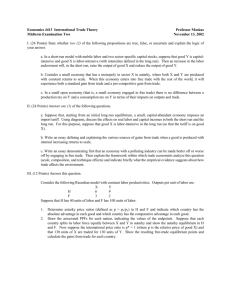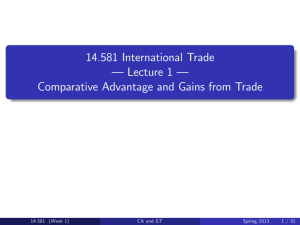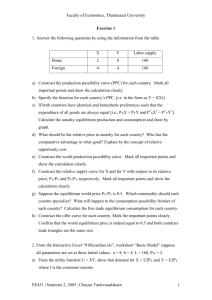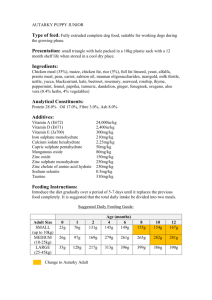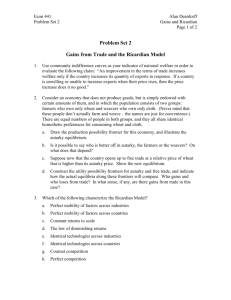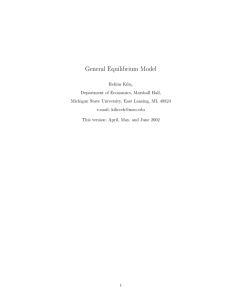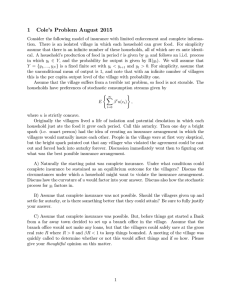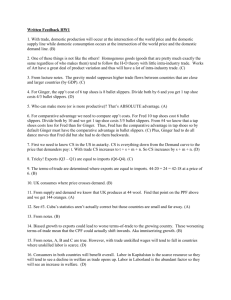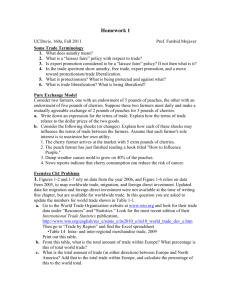14.581 International Trade 1 Standard Assumptions of International Trade
advertisement
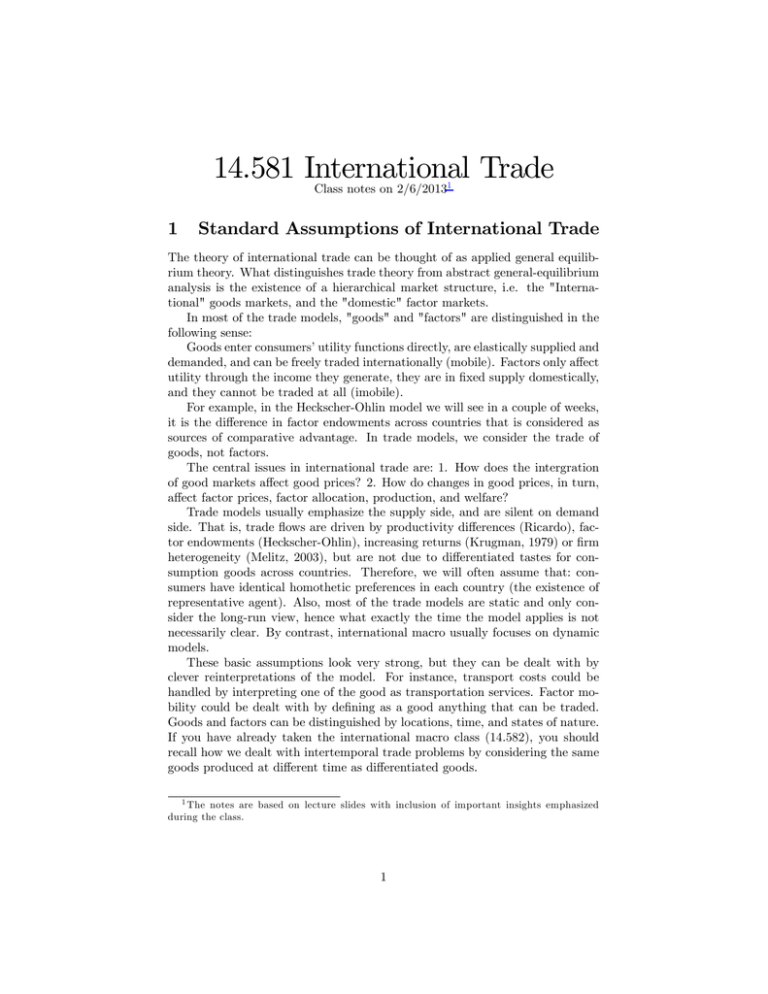
14.581 International Trade Class notes on 2/6/2013 1 1 Standard Assumptions of International Trade The theory of international trade can be thought of as applied general equilibrium theory. What distinguishes trade theory from abstract general-equilibrium analysis is the existence of a hierarchical market structure, i.e. the "International" goods markets, and the "domestic" factor markets. In most of the trade models, "goods" and "factors" are distinguished in the following sense: Goods enter consumers’utility functions directly, are elastically supplied and demanded, and can be freely traded internationally (mobile). Factors only a¤ect utility through the income they generate, they are in …xed supply domestically, and they cannot be traded at all (imobile). For example, in the Heckscher-Ohlin model we will see in a couple of weeks, it is the di¤erence in factor endowments across countries that is considered as sources of comparative advantage. In trade models, we consider the trade of goods, not factors. The central issues in international trade are: 1. How does the intergration of good markets a¤ect good prices? 2. How do changes in good prices, in turn, a¤ect factor prices, factor allocation, production, and welfare? Trade models usually emphasize the supply side, and are silent on demand side. That is, trade ‡ows are driven by productivity di¤erences (Ricardo), factor endowments (Heckscher-Ohlin), increasing returns (Krugman, 1979) or …rm heterogeneity (Melitz, 2003), but are not due to di¤erentiated tastes for consumption goods across countries. Therefore, we will often assume that: consumers have identical homothetic preferences in each country (the existence of representative agent). Also, most of the trade models are static and only consider the long-run view, hence what exactly the time the model applies is not necessarily clear. By contrast, international macro usually focuses on dynamic models. These basic assumptions look very strong, but they can be dealt with by clever reinterpretations of the model. For instance, transport costs could be handled by interpreting one of the good as transportation services. Factor mobility could be dealt with by de…ning as a good anything that can be traded. Goods and factors can be distinguished by locations, time, and states of nature. If you have already taken the international macro class (14.582), you should recall how we dealt with intertemporal trade problems by considering the same goods produced at di¤erent time as di¤erentiated goods. 1 The notes are based on lecture slides with inclusion of important insights emphasized during the class. 1 2 Standard Assumptions of Neoclassical Trade Neoclassic trade models are characterized by three key assumptions: 1. Perfect competition 2. Constant returns to scale (CRS) 3. No distortions Note that we could allow for decreasing returns to scale (DRS) by introducing hidden factors in …xed supply. Increasing returns to scale (IRS) is a much more severe issue addressed by "New" trade theory. (Krugman, 1979, 1980) 3 General Results of Neoclassical Trade Not surprisingly, there are few results that can be derived using only Assumptions 1-3. In future lectures, we will enrich the model with more assumptions and derive sharp predictions for special cases: Ricardo, Assignment, Ricardo-Viner, and Heckscher-Ohlin models. For the moment, let’s stick to the general case and show how simple revealed preference arguments can be used to establish two important resutls. 3.1 Gains from trade (Samuelson 1939) Consider a world economy with n = 1; :::; N countries, each populated by h = 1; :::; Hn households There are g = 1; :::; G goods: yn cnh pn n ) (y1n ; :::; yG Output vector in country n nh (cnh 1 ; :::; cG ) (pn1 ; :::; pnG ) Consumption vector of household h in country n Good price vector in country n There are f = 1; :::; F factors: vn (v1n ; :::; vFn ) wn (w1n ; :::; wFn ) We denote by CRS ) n n Endowment vector in country n Factor price vector in country n the set of combinations (y; v) feasible in country n is a convex cone Revenue function in country n is de…ned as rn (p; v) max fpyj(y; v) 2 y n g Comments (see Dixit-Norman pp. 31-36 for details): 2 Revenue function summarizes all relevant properties of technology Under perfect competition, y n maximizes the value of output in country n: rn (pn ; v n ) = pn y n (1) The expenditure function We denote by unh the utility function of household h in country n Expenditure function for household h in country n is de…ned as enh (p; u) = min pcjunh (c) c u Comments (see Dixit-Norman pp. 59-64 for details): Here factor endowments are in …xed supply, but easy to generalize to case where households choose factor supply optimally Holding p …xed, enh (p; u) is increasing in u Household’s optimization implies enh (pn ; unh ) = pn cnh , (2) where cnh and unh are the consumption and utility level of the household in equilibrium, respectively In the next propositions, when we say “in a neoclassical trade model,” we mean in a model where equations (1) and (2) hold in any equilibrium 3.1.1 One household per country Consider …rst the case where there is just one household per country Without risk of confusion, we drop h and n from all variables Instead we denote by: (y a ; ca ; pa ) the vector of output, consumption, and good prices under autarky (y; c; p) the vector of output, consumption, and good prices under free trade ua and u the utility levels under autarky and free trade Proposition 1 In a neoclassical trade model with one household per country, free trade makes all households (weakly) better o¤ . Proof: e(p; ua ) pca , = py a r (p; v) = e (p; u) by by by by Since e(p; ) increasing, we get u Comments: de…nition of e market clearing under autarky de…nition of r equations (1), (2), and trade balance ua 3 Pa P Figure 1: Fig 1 Two inequalities in the previous proof correspond to consumption and production gains from trade (See Fig 1). Facing the new price vector, households cannot be worse by reoptimizing consumption and production. Previous inequalities are weak. Equality holds if there are kinks in IC or PPF, for example, if production function or utility are Leontif, or if we have an endowment economy. Trade here acts as an expansion of production possibility frontier. Previous proposition only establishes that households always prefer “free trade” to “autarky.” It does not say anything about the comparisons of trade equilibria. 3.1.2 Multiple households per country (I): domestic lump-sum transfers With multiple-households, moving away from autarky is likely to create winners and losers. households already trade among themselves within country may not see their utility increased when the country is opening up to trade. For instance, consider some household holds a bunch of special metal which were selling at a high price under autarky. When the country starts trading with another country that is abundant in this kind of metal. The drop of the relative price of metal implies a lower income for this household, which in turn may result in a lower utility. In order to establish the Pareto-superiority of trade, we will therefore need to allow for policy instruments. We start with domestic lump-sum transfers 4 (full ‡exibility) and then consider less informationally intensive instruments. We now reintroduce the index h explicitly and denote by: cah and ch the vector of consumption of household h under autarky and free trade v ah and v h the vector of endowments of household h under autarky and free trade uah and uh the utility levels of household h under autarky and free trade h the lump-sum transfer from the government to household h ( lump-sum tax and h 0 , lump-sum subsidy) h 0, Proposition 2 In a neoclassical trade model with multiple households per country, there exist domestic lump-sum transfers such that free trade is (weakly) Pareto superior to autarky in all countries Proof: We proceed in two steps Step 1: For any h, set the lump-sum transfer h such that h = (p pa ) cah wa )v h (w The intuition here is that, after opening up trade, household should still be able to purchase the same consumption vector in autarky. Budget constraint under autarky implies pa cah wa v h . Therefore pcah wv h + h Thus cah is still in the budget set of household h under free trade Step 2: By de…nition, government’s revenue is given by P h P P = (pa p) cah (wa w) v h : de…nition of h = (pa p) y a (wa w)v : mc autarky = py a + wv : zp autarky r (p; v) + wv : de…nition r (p; v) = (py wv) = 0 : eq. (1) + zp free trade Comments: Good to know we don’t need international lump-sum transfers. Domestic lump-sum transfers remain informationally intensive. How can the government know the consumption vector cah for each household under autarky? 5 3.1.3 Multiple households per country (II): commodity and factor taxation With this last comment in mind, we now restrict the set of instruments to commodity and factor taxes/subsidies. More speci…cally, suppose that the government can a¤ect the prices faced by all households under free trade by setting good and factor phousehold whousehold = p+ = w+ go o d factor Proposition 3 In a neoclassical trade model with multiple households per country, there exist commodity and factor taxes/subsidies such that free trade is (weakly) Pareto superior to autarky in all countries Proof: Consider the two following taxes: go o d = pa p factor = wa w By construction, household is indi¤erent between autarky and free trade. Now consider government’s revenues. By de…nition P h go o d P ah f actor P h = c v P ah P a a = (p p) c (w w) v h 0, for the same reason as in the previous proof. Comments: Previous argument only relies on the existence of production gains from trade. This means that the whole proof fails if there only exists consumption gains, e.g. endowment economy. If there is a kink in the PPF, we know that there aren’t any production gains. Similar problem with “moving costs”. See Feenstra p.185 Factor taxation still informationally intensive: need to know endowments per e¢ ciency units, may lead to di¤erent business taxes 3.2 Law of Comparative Advantage (Deardor¤ 1980) The previous results have focused on normative predictions. We now demonstrate how the same revealed preference argument can be used to make positive predictions about the pattern of trade Principle of comparative advantage: Comparative advantage— meaning di¤erences in relative autarky prices— is the basis for trade 6 Why? If two countries have the same autarky prices, then after opening up to trade, the autarky prices remain equilibrium prices. So there will be no trade.... The law of comparative advantage (in words): Countries tend to export goods in which they have a CA, i.e. lower relative autarky prices comp to other countries Pared P nh n Let tn y1n cnh ; :::; yG c denote net exports in country n Let uan and un denote the utility level of the representative household in country n under autarky and free trade Let pan denote the vector of autarky prices in country n Without loss of generality, normalize prices such that: P P pg = pan g = 1, Notations: cov (x; y) p var (x) var (y) Pn cov (x; y) = x) (yi i=1 (xi 1 Pn x = xi n i=1 cor (x; y) = y) Proposition 4 In a neoclassical trade model, if there is a representative household in country n, then cor (p pa ; tn ) 0 Proof: Since (y n ; v n ) 2 n , the de…nition of r implies pa y n r (pa ; v n ) Since un (cn ) = un , the de…nition of e implies pa cn e (pa ; un ) The two previous inequalities imply p a tn Since un r (pa ; v n ) e (pa ; un ) (3) uan by Proposition 1, e (pa ; ) increasing implies e(pa ; un ) e(pa ; una ) Combining inequalities (3) and (4), we obtain pa tn r (pa ; v n ) e(pa ; una ) = 0, where the equality comes from market clearing under autarky. Because of balanced trade, we know that ptn = 0 7 (4) Hence pa ) tn (p 0 By de…nition, cov (p pa ; t n ) = which can be rearranged as cov (p P g pg pa ; tn ) = (p pag p a ) tn p + pa tgn pa ) t G (p t n , n Given our price normalization, we know that p = pa . Hence cov (p pa ; tn ) = (p p a ) tn 0 Proposition 4 derives from this observation and the fact that sign [cor (p pa ; tn )] = sign [cov (p pa ; tn )] Comments: With 2 goods, each country exports the good in which it has a CA, but with more goods, this is just a correlation Core of the proof is the observation that pa tn 0 It directly derives from the fact that there are gains from trade. Since free trade is better than autarky, the vector of consumptions must be at most barely attainable under autarky (pa y n pa cn ) For empirical purposes, problem is that we rarely observe autarky... In future lectures, we will look at models which relate pa to (observable) primitives of the model: technology and factor endowments 8 MIT OpenCourseWare http://ocw.mit.edu 14.581 International Economics I Spring 2013 For information about citing these materials or our Terms of Use, visit: http://ocw.mit.edu/terms.
